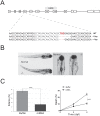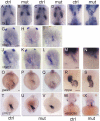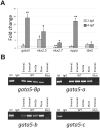smarce1 mutants have a defective endocardium and an increased expression of cardiac transcription factors in zebrafish
- PMID: 30337622
- PMCID: PMC6194089
- DOI: 10.1038/s41598-018-33746-8
smarce1 mutants have a defective endocardium and an increased expression of cardiac transcription factors in zebrafish
Abstract
SWI/SNF or BAF chromatin-remodeling complexes are polymorphic assemblies of homologous subunit families that remodel nucleosomes and facilitate tissue-specific gene regulation during development. BAF57/SMARCE1 is a BAF complex subunit encoded in animals by a single gene and is a component of all mammalian BAF complexes. In vivo, the loss of SMARCE1 would lead to the formation of deficient combinations of the complex which might present limited remodeling activities. To address the specific contribution of SMARCE1 to the function of the BAF complex, we generated CRISPR/Cas9 mutations of smarce1 in zebrafish. Smarce1 mutants showed visible defects at 72 hpf, including smaller eyes, abnormal body curvature and heart abnormalities. Gene expression analysis revealed that the mutant embryos displayed defects in endocardial development since early stages, which led to the formation of a misshapen heart tube. The severe morphological and functional cardiac problems observed at 4 dpf were correlated with the substantially increased expression of different cardiac transcription factors. Additionally, we showed that Smarce1 binds to cis-regulatory regions of the gata5 gene and is necessary for the recruitment of the BAF complex to these regions.
Conflict of interest statement
The authors declare no competing interests.
Figures






Similar articles
-
Critical role of Brg1 member of the SWI/SNF chromatin remodeling complex during neurogenesis and neural crest induction in zebrafish.Dev Dyn. 2006 Oct;235(10):2722-35. doi: 10.1002/dvdy.20911. Dev Dyn. 2006. PMID: 16894598
-
Assembly and interaction of core subunits of BAF complexes and crystal study of the SMARCC1/SMARCE1 binary complex.Biochem Biophys Res Commun. 2022 Apr 9;599:9-16. doi: 10.1016/j.bbrc.2022.02.007. Epub 2022 Feb 7. Biochem Biophys Res Commun. 2022. PMID: 35158202
-
BAFfling pathologies: Alterations of BAF complexes in cancer.Cancer Lett. 2018 Apr 10;419:266-279. doi: 10.1016/j.canlet.2018.01.046. Epub 2018 Jan 31. Cancer Lett. 2018. PMID: 29374542 Review.
-
The developmental and pathogenic roles of BAF57, a special subunit of the BAF chromatin-remodeling complex.FEBS Lett. 2016 Jun;590(11):1555-69. doi: 10.1002/1873-3468.12201. Epub 2016 May 20. FEBS Lett. 2016. PMID: 27149204 Review.
-
Molecular basis of CD4 repression by the Swi/Snf-like BAF chromatin remodeling complex.Eur J Immunol. 2009 Feb;39(2):580-8. doi: 10.1002/eji.200838909. Eur J Immunol. 2009. PMID: 19180471 Free PMC article.
Cited by
-
The Zebrafish Cardiac Endothelial Cell-Roles in Development and Regeneration.J Cardiovasc Dev Dis. 2021 May 1;8(5):49. doi: 10.3390/jcdd8050049. J Cardiovasc Dev Dis. 2021. PMID: 34062899 Free PMC article. Review.
-
Epigenetic Regulation of Fibroblasts and Crosstalk between Cardiomyocytes and Non-Myocyte Cells in Cardiac Fibrosis.Biomolecules. 2023 Sep 12;13(9):1382. doi: 10.3390/biom13091382. Biomolecules. 2023. PMID: 37759781 Free PMC article. Review.
-
Smarce1 and Tensin 4 Are Putative Modulators of Corneoscleral Stiffness.Front Bioeng Biotechnol. 2021 Feb 5;9:596154. doi: 10.3389/fbioe.2021.596154. eCollection 2021. Front Bioeng Biotechnol. 2021. PMID: 33634081 Free PMC article.
-
Genetic mapping and molecular mechanism behind color variation in the Asian vine snake.Genome Biol. 2023 Mar 9;24(1):46. doi: 10.1186/s13059-023-02887-z. Genome Biol. 2023. PMID: 36895044 Free PMC article.
-
Single-cell transcriptomic analysis of vascular endothelial cells in zebrafish embryos.Sci Rep. 2022 Jul 29;12(1):13065. doi: 10.1038/s41598-022-17127-w. Sci Rep. 2022. PMID: 35906287 Free PMC article.
References
Publication types
MeSH terms
Substances
LinkOut - more resources
Full Text Sources
Molecular Biology Databases

